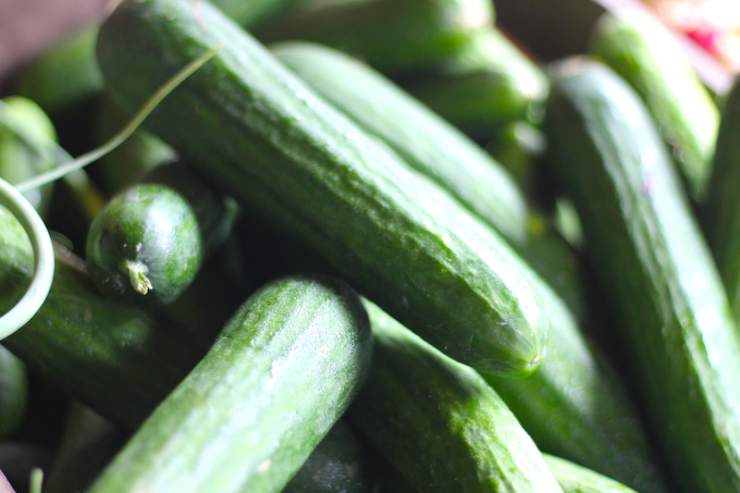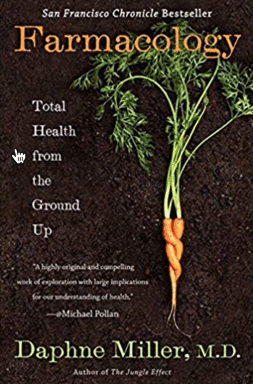
The first time I visited a farmers market, I was living in downtown Chicago, working at a small college, and feeling a little homesick for my rural home in Indiana. I had seen a flyer for the upcoming market on a bulletin board at our neighborhood grocery store. When I walked the four blocks on a Saturday morning to hear violin music humming and neighbors freely chatting, to see buckets full of gladiolas and booth after booth of fresh-picked tomatoes and zucchini, I felt my feet sink a little deeper into the Windy City pavement. Somehow, the market made Chicago feel more like home.
I went to that market as often as I could, schlepping home bags full of fragrant basil, buttery sweet corn, and heirloom tomatoes in various shades of orange, purple, and red. But my time in Chicago spanned just one full summer, and the next couple of cities during my young-adult decade-of-continuous-moves didn’t have a weekly market. It wasn’t until a few years later when I was living in Indianapolis—back to my home state, but culturally still far away from life on the farm—that I began my serious commitment to attending farmers markets.
For several years I was single, and though occasionally I’d haul my cloth bags and coffee tumbler to the market alone, I preferred those Saturday mornings when I would meet up with friends so we could do our shopping together. Now, my husband and I go together whenever we can. But it isn’t just about the friends or family members I go with. Going to the farmers market is as much about the people I meet while I’m there: local farmers and bakers, artisans and herdsmen, and others from the community who come to do their shopping. I talk to the vendors about their growing techniques and ask for tips on how to cook a certain type of eggplant or squash. One farmer used to sort his tomatoes based on ripeness and readiness for eating. Planning to have a tomato sandwich today? He’d point to the right end of his pile. Want a slicer for dinner two days from now? Pick from the left end. I found that out because I talked to him.
When I read Daphne Miller’s account of visiting the Mid-Bronx Farmers Market in Chapter 5 of Farmacology, it all sounded so familiar. Vendors catching up among the boxes of greens; families from the neighborhood getting cooking advice along with their tomatoes and beets. But the farmers market Miller described was just one facet of the urban farm she was writing about. La Familia Verde Urban Farms, a collective of several community gardens throughout south-central Bronx, is run by Karen Washington, an in-home physical therapist and an urban farmer. The collective began with an initiative by the New York Botanical Garden to transform empty lots into community gardens. The first one just happened to be across from Karen’s house. Now she leads the group of five gardens that have joined together to transform their community, including donating a portion of their farmers market profits back to the organization.
But for what purpose? Of course having a lush garden instead of a trash-filled, graffiti-tagged lot goes a long way toward neighborhood beautification. But the benefits of La Familia Verde go way beyond aesthetics. For one, studies show that children who eat from local farms are more likely to eat fruits and vegetables at every meal … unlike other research that revealed adding new grocery stores into urban food deserts does not encourage healthier eating. Miller also cites another study that shows people are more likely to buy vegetables if they can do it in passing, like at the Mid-Bronx Farmers Market.
The benefits of community gardening go way beyond nutrition, though. Gardening of any type has been shown to be an effective preventive “medicine” for older adults, reducing incidents of falling, depression, and dementia as compared with nongardeners. Then there was the economic stimulus: when people became part of La Familia Verde, they began to see the possibilities of selling more than just produce. One young man began baking, selling his cakes and other wares at the weekly farmers market. Another family sold tamales.
When Miller noticed that even crime rates were reduced by community gardens, she decided to dig deeper into what was really going on. So many positive benefits just from growing peas and carrots? She remembered a study she’d read about neighborhoods in Chicago, where the crime rates varied so significantly. Researchers concluded “that what made the biggest difference in crime rates was not economic status but something the authors referred to as ‘collective efficacy’—a community-wide belief that the members of a community could make a difference by working together.”
When Miller looked at what increases efficacy, she found it was all the things that La Familia Verde was doing at the gardens and the farmers markets: “The multigenerational collaboration, the storytelling, the shared (delicious) meals, the incubation of businesses, the political discussions, the physical labor in the sunshine, the kindness to neighbors, the volunteerism at the market, the connection to family tradition, the sense of self-sufficiency, the interface with local agencies, the youth involvement—these were all sparks of collective efficacy that La Familia Verde had ignited in the once-blighted mid-Bronx.”
In helping readers know how to create a little collective efficacy in their own neighborhoods, Miller suggests putting a garden in the front yard rather than the back, where you they are “much more likely to interact with their neighbors.” She also suggests sharing homegrown produce with neighbors and putting gardens in schools, all ways to build on relationships and create healthfulness for all. But mostly she suggests starting small and simply, and making sure what you build its accessible and beautiful.
As I’ve thought more about collective efficacy, I can’t help but think of the writing life, how so many experiences, talents, relationships, conversations, and habits converge to form words on the page. Good writing isn’t about talent or opportunity or habits on their own: Even the most talented writer won’t produce a word unless he creates a habit to regularly sit down to write. Or the writer with lots of opportunity won’t complete polished pieces unless she develops her talent. And the writer who isolates herself to maximize productivity may fizzle out from discouragement unless she builds a community around her.
I also can’t help but think that Miller’s suggestions for collective efficacy sound a lot like what happens here at Tweetspeak Poetry: an interactive community, accessible to all, and oh so beautiful. Here, everything works together to create a sense of goodness for all: from the extended work of writing and publishing books, to the celebrations of public days, from the interaction in workshops, to the comments left on blog posts. As Miller writes near the end of chapter 5, “Now that is a sustainable cycle.”
Write It Out
How much do you and the people around love the place where you live? How much collective efficacy does your neighborhood have? Write about the steps you’ve already taken to make the place you live healthier and more beautiful, and if you’ve taken no such steps, how could you start today?
What about your writing life? How are all the disparate pieces coming together to build a writing life that will last? Is something missing? Do you need to begin again? How can you tap into the collective efficacy of Tweetspeak? Write about your own creative collective efficacy and develop a plan going forward.
Read With Us
This month, we’re reading Farmacology: Total Health from the Ground Up together.
Photo by L.L. Barkat. Used with permission. Post by Charity Singleton Craig.
- Grammar for a Full Life Book Club: On Becoming Less Possessive - June 16, 2021
- Grammar for a Full Life Book Club: Chilling Out on the Grammar Rules - June 9, 2021
- Grammar for a Full Life Book Club: A Passive Voice - June 2, 2021

Megan Willome says
You’ve really hit on what makes Tweetspeak special, Charity. It is both an encouraging writing community and one what pushes us to be bold–try that kumquat!
Charity Singleton Craig says
Yes, Megan! I’ve tried many a proverbial kumquat at the suggestion of Tweetspeak.
Will Willingham says
Kids who live near gardens eat vegetables. Wild that we’d need to study to know this. I actually think that one of my kids who used to mess with my garden with me did start liking vegetables much more when he started helping me. Part of it was just getting to an age where he was just more open to different foods. But I do think it was proximity to the plants and vegetables, caring for them and watching them mature. (Not to mention just being able to walk outside and find food…)
Charity Singleton Craig says
I also thought it was a funny bit of a science that seems pretty self-evident, Will. But it’s science so many of us seem to have moved on from as our lives move further and further away from the dirt. My senior in high school is taking a cooking class this trimester, and he was telling me about the cilantro they are growing there. Suddenly, he’s so much more into herbs. I just love that!